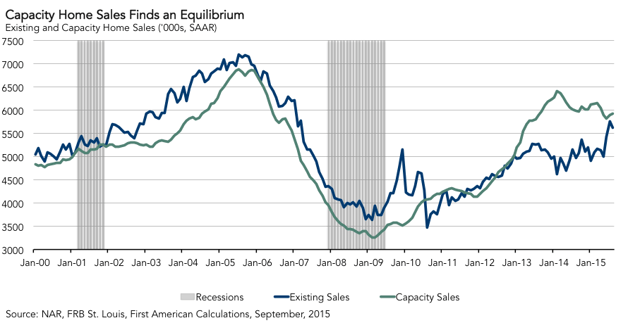Market capacity for existing-home sales has remained close to
six million sales on an annualized basis for more than a year
First American’s proprietary Existing-Home Sales Capacity (EHS-C) model provides a gauge on whether existing-home sales are under capacity or over capacity based on current market fundamentals. For the month of August, the EHS-C rate increased by 0.4 percent compared to July and decreased by 1.1 percent compared to a year ago. The seasonally adjusted, annualized rate (SAAR) of existing-home sales capacity is up 82.1 percent from the low point of sales reached in February 2009*.
The EHS-C increased by 26,000 (SAAR) in August. The two-tenths of a percent drop in the unemployment rate and continued rise in disposable income were factors that helped push the market capacity for existing-home sales higher. Additionally, continued gains in house prices and the mortgage rate falling below 4 percent again were also factors that contributed. Market capacity for existing-home sales has remained close to 6 million sales on an annualized basis for more than a year, while actual sales activity has increased and significantly closed the gap between market capacity and actual existing-home sales. This year, through July, actual existing-home sales have increased by almost 800,000 sales.
Today, the Federal Reserve may decide to raise the benchmark federal funds rate. This week, we published an analysis of the impact of a possible rate increase on existing-home sales and house prices entitled "Does a Fed Rate Increase Doom Housing?" We concluded that while the housing market isn’t doomed by a Fed rate increase, it would modestly adjust, along with a modest decline in market capacity, as well.
Earlier this week, Redfin reported the results of a survey of homebuyers indicating that if mortgage rates rise to 5 percent (a highly unlikely scenario in the near future) most homebuyers would stay in the market. According to the Redfin survey, homebuyers would adjust their approach by looking for a less expensive house (44 percent), or saving more for a down payment (21 percent). This is further evidence of the modest impact an increase in interest rates has on housing demand at the moment.

EHS-C is down 480,000 (SAAR) from the most recent peak in February 2014. Actual existing-home sales improved dramatically this summer to narrow the gap between market capacity and actual sales. The current underperformance gap is an estimated 307,000 (SAAR), which is significantly less than the sales capacity gap of 1.7 million existing-home sales in February 2014.
The primary reason for the improvement in the underperformance gap between market capacity and actual existing-home sales is the release of pent-up housing supply triggered by existing homeowners with improving equity positions due to robust house price appreciation putting their homes on the market. In addition to more sellers also becoming buyers, household formation is gaining strength and will become a source of first-time homebuyer demand. Millennials and boomerang buyers – those who were foreclosed on during the crisis but have since repaired their credit – will be an increasing source of demand for existing-home sales.
Early forecasts for August actual existing-home sales predict an increase to 5.64 million seasonally adjusted at an annualized rate. This would be an increase of just 1 percent over July. This should not necessarily be taken as an indication of any major shifts in the market. Instead, it should be considered a reflection of the fact that actual existing-home sales are beginning to approach fundamentally supported market capacity. As actual existing-home sales and market capacity for existing-home sales converge, a decrease in the pace of change is to be expected.
The housing market seems to be approaching a new equilibrium with existing-home sales capacity in the neighborhood of 6 million, with actual sales closing the underperformance gap. Even the risk of rising rates may not warrant much concern, as most borrowers are indicating that they will adjust without dropping out of the market and our proprietary model shows the overall impact of a rate increase to be modest.
Next EHS-C release: October 20, 2015 for September EHS-C
*Previous EHS-C releases referred to November 2011 as the low point of sales. The model used to generate existing-home sales capacity has been enhanced to more accurately reflect the dynamic relationships between sales, prices, interest rates and the user-cost of housing, resulting in a model that more accurately reflects past conditions.
About Existing-Home Sales Capacity
First American’s proprietary Existing-Home Sales Capacity (EHS-C) model provides a gauge on whether existing-homes sales are under capacity or over capacity based on current market circumstances. The EHS-C rate provides a measure on whether existing-homes sales, which include single-family homes, townhomes, condominiums and coops, are outperforming or underperforming based on current market fundamentals. The seasonally adjusted annualized EHS-C estimates the historical relationship between existing-home sales and the U.S. population demographic data, income and labor market conditions in the U.S. economy, price trends in the U.S. housing market, and conditions in the financial market. For example, seasonally adjusted, annualized rates of existing-home sales above the level of the EHS-C indicate market turnover is outperforming the rate fundamentally supported by the current conditions. Conversely, seasonally adjusted, annualized rates of existing-home sales below the level of the EHS-C indicate market turnover is underperforming the rate fundamentally supported by the current conditions. Actual seasonally adjusted, annualized existing-home sales may exceed or fall short of the capacity rate of sales for a variety of reasons, including non-traditional market conditions, policy constraints and market participant behavior. Recent EHS-C estimates are subject to revision in order to reflect the most up-to-date information available on the economy, housing market and financial conditions. The EHS-C will be published prior to National Association of Realtors Existing-Home Sales report each month.



